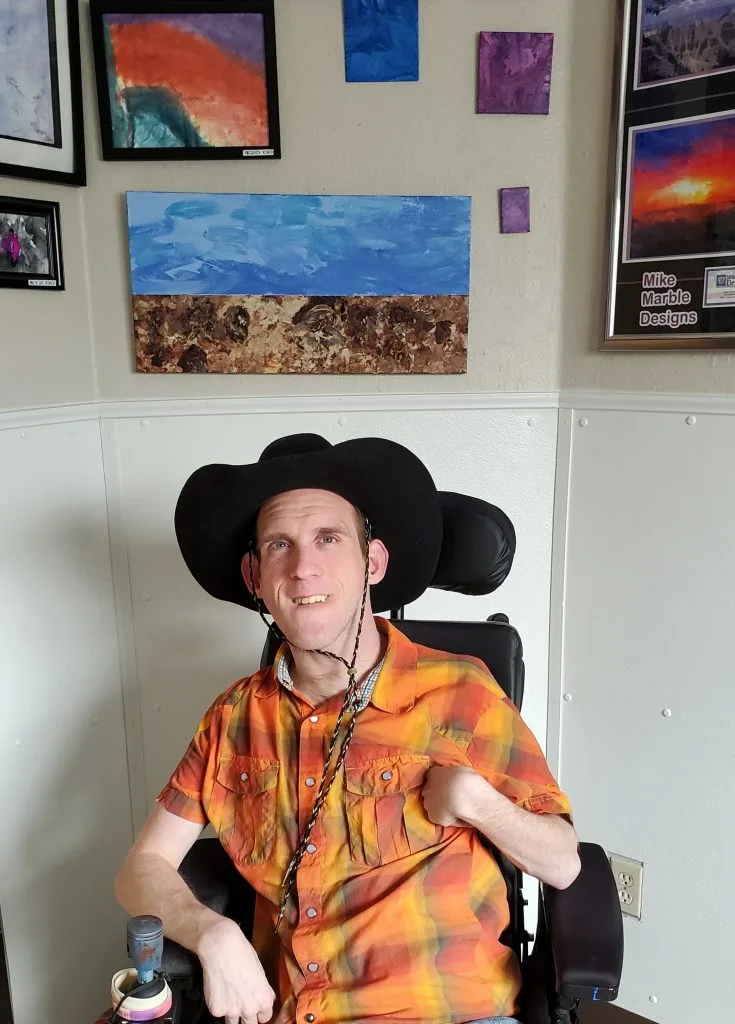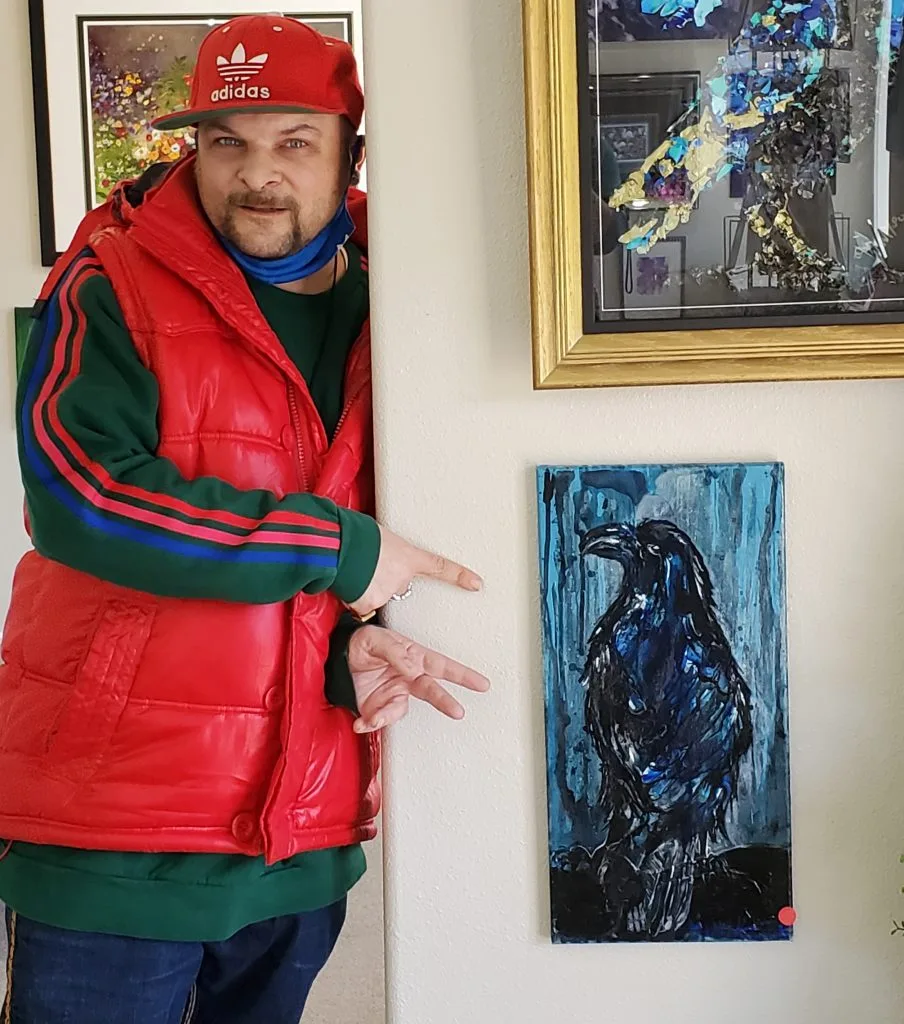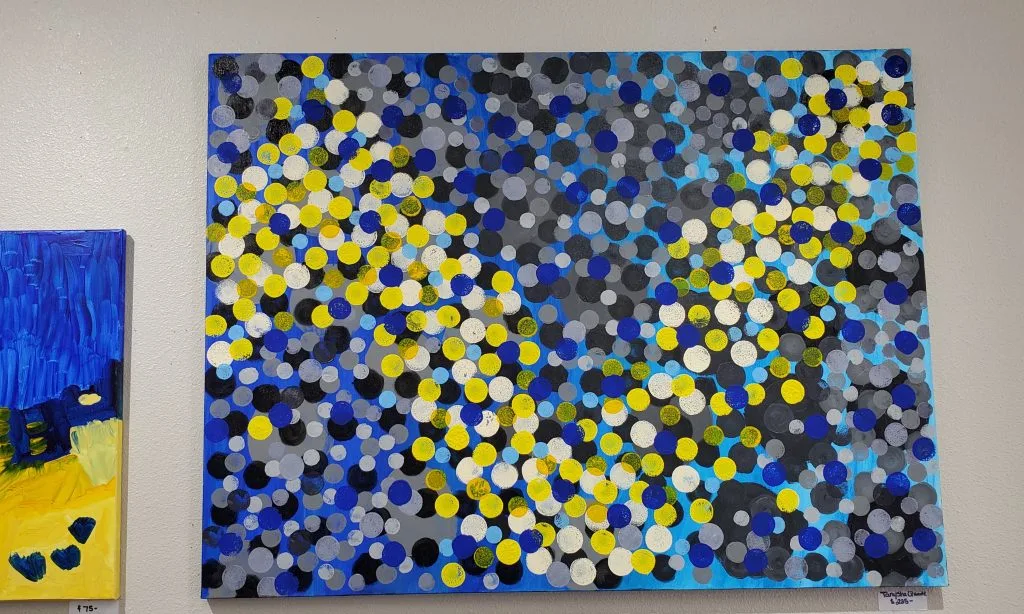Support our diverse communities by buying tickets from the ALSO HEARTS raffle fundraiser! Tickets are available until July 31st, 2025.
Support our diverse communities by buying tickets from the ALSO HEARTS raffle fundraiser! Tickets are available until July 31st, 2025.


“A lot of times, at a restaurant or a store, people just look at the wheelchair and don’t get to know the person behind the disability,” says Mike Marble. “Oftentimes the person behind the disability has a lot to offer, if people would just look…Art gives you a way to show people what’s below the surface.”
As one of the artists at ALSO Arts, a community art studio and art program for adults with developmental disabilities, Mike has that opportunity. ALSO Arts provide Mike—and eleven other artists—with the means to create, show, and sell their art. Through this program, these artists are able to show people what’s beneath the surface. Students receive coaching from lead studio assistant/gallery manager Amanda Smith, as well as other volunteer artists. They get studio space and materials, professional framing from award-winning framer Donna Erwin, and wall space in a professional gallery that fronts Troutdale’s historic downtown. This gallery displays work from students as well as outside artists.
The respect that comes from having art exhibited in a professional space is important to the artists, as is the money. “When pieces sell, our student artists get 70 percent and 30 percent is rolled back into the art program” says Amanda. Outside artists receive a more traditional 55/45 split, though that can change. Many of the artists receive Social Security Insurance, which is around $841 a month, but are not employed elsewhere. They consider selling their art a business opportunity. “I come from an artistic and entrepreneurial family, so I’m just following in their footsteps” says Mike. “It may not be mainstream, but this is still a business and I’m trying to grow it…ALSO is helping me with the business of art.” Other ALSO artists agree. Mike Kordowski says he sometimes makes choices on what to paint based on what might sell. Tina Schultz is always happy when one of her pieces sells, “because [she] likes to shop.” And Tanysha Quade enjoys the fact that she’s been selling more and more. “It gives me confidence,” she says.

The art is so much more than a business for all of the artists. “It’s a way to express myself,” says Mike Kordowski. “In a healthy way,” Amanda adds with a smile. “I think it’s relaxing,” says Tanysha. “Especially on stressful days when I come in here I tend to relax. I do artwork at home, too, just to get away from the craziness.” Mike Marble creates abstracts in part because he has difficulty with fine motor skills, however, he says his art is not influenced by his disability, but rather by his personality. “I’m very loud, outspoken, and opinionated and can be a bit intense sometimes. You can see that in my artwork, in the very bright, very loud, very intense colors.”
Art can also give people a way to communicate. When Tina Schmidt first came to ALSO, the artist working with her did not know American Sign Language, so Tina was unable to tell her that she wasn’t feeling well. She painted herself green to communicate this.

Tina painted the picture below her portrait just a year and a half after joining the art program at ALSO, demonstrating the value of the professional instruction available to the artists. Her skill has only increased over the years. “Look at this piece,” says Amanda. “This looks like it could hang with masterpieces.”
Often, adults with disabilities arriving at ALSO have had little opportunity for art lessons. “In public school, when you need extra help, they don’t pull you from math class, they pull you from art class,” says Amanda. Mike Kordowski says his art has changed dramatically since working with ALSO Arts. “Stuff didn’t go together that great when I first started. Later down the road it progressed, and stuff started to make sense and look good.” Mike Marble, who created only digital art before coming to ALSO Arts, says, “All of what I know how to do with a paintbrush came from them. Everything from color theory to composition to how to show my art.”

ALSO Arts students also get the chance to explore. “It’s not like a classroom,” says Tanysha. “You get to do whatever you want.” One time, Tanysha, who likes to work in mixed media, brought back sand from the beach to incorporate into one of her pieces. She says, “I swear the canvas weighed 50 pounds by the time it dried.”
There’s another, less obvious benefit to participating in ALSO Arts. “There isn’t anything else out there like this,” says Tanysha. “We have friendships here, more like family. It’s not just about painting or the selling of art. It’s about the friendships.”
“It (ALSO Arts) provides us with an outlet to meet people; to create friendships and build relationships with fellow artists, opportunities we most likely wouldn’t have had,” says Mike Marble, who encourages other adults with disabilities to join them at the community art studio. “A lot of people with talent don’t really have the outlet to express themselves, or know how to put themselves out there, or find the people that can help them grow creatively.” It’s important to Mike personally, too. He wants people to see below the surface. “I do not want the world to pass me by,” he says. “I have too much to offer.”

Sign up for our newsletter to get our latest news, content, and job opportunities.
Help us ensure that everyone has the same opportunities in their home, workplace and community. Let’s make dreams!
